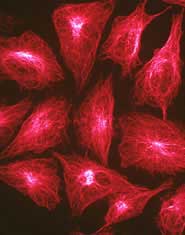Stop and search

Proteins from the cell’s skeleton make roaming robots. <br>© SPL <br>
Glowing nanobots map microscopic surfaces.
Unleashing hordes of molecular robots to explore a surface’s terrain can produce maps of microscopic structures and devices with higher resolutions than those produced by conventional microscopes, new research shows.
Each robot has a ’light’ attached to it, allowing its random movements to be tracked around obstacles, through cracks or under overhangs. Adding the paths of hundreds of wandering nanobots together builds up a map of the entire surface1.
To build their nanobots, Viola Vogel and colleagues at the University of Washington in Seattle modified natural molecular machines called microtubules. These are cylinders of a protein called tubulin, stacked like the bricks in a chimney. Normally, they act as scaffolding inside cells, known as the cytoskeleton, which controls cell shape. ’Motor’ proteins called kinesins shuttle materials around cells along the microtubule gangways.
To create self-propelled nanoscale robots, Vogel’s team reversed nature’s arrangement. By fixing kinesin molecules all over a surface, wormlike microtubules propel themselves randomly all over the surface. By attaching a fluorescent dye to the microtubules, the researchers can follow where they go – and where they don’t.
The immobilized kinesin molecules drive microtubules up and down smooth slopes, but they cannot propel them up steep walls because the microtubules are too stiff to bend up a sharp incline. These limits to the tubule’s peregrinations produce a topographical map of surfaces.
Because microtubule nanobots can penetrate holes, cavities and pores, they can reach places that cannot be seen by passively gazing through a microscope. Their progress would still remain visible if the surface is transparent to the light emitted by the probes.
What’s more, Vogel’s team claims, the robots could be designed to investigate specific aspects of a surface, such as regions that are attractive or repulsive to water. This information could help researchers to understand, for example, the structure of porous materials, the architecture of biological tissues, or the shapes of large molecules sitting on a surface.
In principle, nanobots should be able to see features that are less than 50 nanometres (millionths of a millimetre) across. Smaller details – perhaps down to one nanometre – might be visible if smaller ’molecular robots’ are created, the researchers hope.
The time required for the robots to explore the accessible surface fully depends on how many of them there are and on how fast they move (about 250 nm per second for microtubules). The researchers were able to map out their test surface by superimposing 500 images at a rate of one every 5 seconds.
References
Hess, H., Clemmens, J., Howard, J. & Vogel, V. Surface imaging by self-propelled nanoscale probes. Nano Letters 2, 113 – 116, (2002).
Media Contact
All latest news from the category: Life Sciences and Chemistry
Articles and reports from the Life Sciences and chemistry area deal with applied and basic research into modern biology, chemistry and human medicine.
Valuable information can be found on a range of life sciences fields including bacteriology, biochemistry, bionics, bioinformatics, biophysics, biotechnology, genetics, geobotany, human biology, marine biology, microbiology, molecular biology, cellular biology, zoology, bioinorganic chemistry, microchemistry and environmental chemistry.
Newest articles

High-energy-density aqueous battery based on halogen multi-electron transfer
Traditional non-aqueous lithium-ion batteries have a high energy density, but their safety is compromised due to the flammable organic electrolytes they utilize. Aqueous batteries use water as the solvent for…

First-ever combined heart pump and pig kidney transplant
…gives new hope to patient with terminal illness. Surgeons at NYU Langone Health performed the first-ever combined mechanical heart pump and gene-edited pig kidney transplant surgery in a 54-year-old woman…

Biophysics: Testing how well biomarkers work
LMU researchers have developed a method to determine how reliably target proteins can be labeled using super-resolution fluorescence microscopy. Modern microscopy techniques make it possible to examine the inner workings…





















